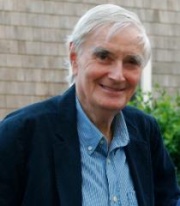Hopkins Budd
Da Ufopedia.
| Questa voce ha bisogno di essere tradotta. |
Budd Hopkins (born on June 15, 1931 in Wheeling, West Virginia) is a central figure in abduction phenomenon and related UFO research.[1] He is also a painter and sculptor of note.
Indice |
Early life and career
Born and raised in Wheeling, West Virginia. He graduated from Oberlin College in 1953, that same year moving to New York City, which has been his home since then.
Hopkins' art is in the permanent collections in the Whitney Museum, the Guggenheim Museum, Hirshhorn Museum, and at the Museum of Modern Art; he has received grants or endowments from the Guggenheim Foundation and the National Endowment for the Arts. His articles on art have appeared in leading magazines and journals, and he has lectured at many art schools including Truro Center for the Arts at Castle Hill
Interest in UFOs
In 1964, Hopkins and two others saw a UFO in daylight for several minutes. Fascinated, he joined UFO research group NICAP and began reading many UFO books and articles.
In 1975, Hopkins and Ted Bloecher studied a multiple-witness UFO report, the North Hudson Park UFO sightings which occurred in New Jersey. In 1976, the Village Voice printed Hopkins' account of the investigation.
Hopkins began receiving regular letters from other UFO witnesses, including a few cases of what would later be called "missing time": inexplicable gaps in one's memory, associated with UFO encounters.
Alien abduction
With Bloecher and psychologist Aphrodite Clamar, Hopkins began investigating the missing time experiences, and eventually came to conclude that the missing time cases were due to alien abduction.
By the late 1980s, Hopkins was one of the most prominent people in ufology, earning a level of mainstream attention that was nearly unprecedented for the field. He established the non-profit Intruders Foundation 1989 to publicize his research.
Hopkins has written several popular books about abductees, notably Missing Time, and is the founder of the Intruders Foundation, a non-profit organization created to document and research alien abductions, and to provide support to abductees.
For roughly the first seven years of his investigation of the abduction phenomenon, Hopkins himself conducted no hypnosis sessions. Rather, he secured the aid of licensed professionals. He notes that three of these therapists (Drs. Robert Naiman, Aphrodite Clamar and Girard Franklin) were quite skeptical of the reality of abduction claims, yet all uncovered detailed abduction scenarios from their patients. (Hopkins, 218)
Controversy has been a persistent feature of Hopkins' career in alien abduction and UFO studies. While few seem to doubt Hopkin's motives or sincerity, critics charge that Hopkins is out of his element when he uses hypnosis, thereby aiding his subjects in confabulation: the blending of fact and fantasy. However, Hopkins insists such criticism is specious. He writes, "I have often frequently invited interested therapists, journalists and academics to observe hypnosis sessions. Theoretical psychologist Nicholas Humphrey, who has held teaching positions at both Oxford and Cambridge Universities, and psychiatrist Donald. F. Klein, director of research at the New York State Psychiatric Institute and professor of psychiatry at the College of Physicians and Surgeons, Columbia University, are but two of those who have observed my work firsthand. None of these visitors ... have reported anything that suggested I was attempting to lead the subjects." (Hopkins, 238-239)
The 1992 film Intruders was based on Hopkins' research, and portrayed abduction scenes. Additionally, Hopkin's 1996 book, Witnessed, portrays a classic abduction case that occurred in late 1989 near the Brooklyn Bridge in New York City. This case is unique in that it is one of the first publicized episodes that involved multiple abductees (who did not previously know each other) that come to know each other in the "real" world through a variety of circumstances connected to their abductions. Additionally, this case involved inter-generational abductions within the same family.
See also
- Abduction phenomenon
- Area 51: The Alien Interview
- Extraterrestrial life
- Extraterrestrial life in popular culture
- List of alleged UFO-related extraterrestrials
- Little green men
- Zeta Reticuli
- Dr David Jacobs
- John Edward Mack
References
- Clark, Jerome, The UFO Encyclopedia: The Phenomenon from the Beginning, Volume 1, A-K Detroit: Omnigraphics, 1998 (2nd edition, 2005), ISBN 0-7808-0097-4
- Clark, Jerome, The UFO Encyclopedia: The Phenomenon from the Beginning, Volume 2, L-Z Detroit: Omnigraphics, 1998 (2nd edition, 2005), ISBN 0-7808-0097-4
- Budd Hopkins; "Hypnosis and the Investigation of UFO Abduction Accounts"; pages 215-240 in UFOs and Abductions: Challenging the Borders of Knowledge, David M. Jacobs, editor; University Press of Kansas, 2000; ISBN 0-7006-1032-4)
- Philip Klass: UFO Abductions: A Dangerous Game
External links
- IntrudersFoundation: Hopkins' Official Site
- A PBS Interview with Hopkins
- B. Hopkins biography at Ufopsi
- Art biography of Hopkins
- [1] Budd Hopkins at the March 29, 2008 FortFest conference sponspored by theInternational Fortean Organization
Errore nella funzione Cite: Sono presenti dei marcatori
<ref> ma non è stato trovato alcun marcatore <references/>
